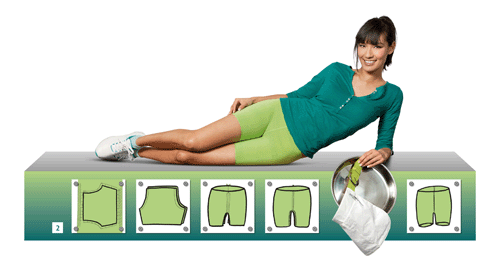
Taking a direct approach in Indonesia
Ready-to-use products save resources and are therefore right on trend, but they have to be developed and manufactured with great attention to detail. Karl Mayer’s DJ series of machines now offers even more scope when it comes to designing lingerie and clothing products and the warp knitting machine building company has developed two new processes for producing seamless briefs, which show just how it’s done. More specifically, these innovations relate to proces

4th February 2011
Knitting Industry
|
Obertshausen
 Ready-to-use products save resources and are therefore right on trend, but they have to be developed and manufactured with great attention to detail. Karl Mayer’s DJ series of machines now offers even more scope when it comes to designing lingerie and clothing products and the warp knitting machine building company has developed two new processes for producing seamless briefs, which show just how it’s done.
Ready-to-use products save resources and are therefore right on trend, but they have to be developed and manufactured with great attention to detail. Karl Mayer’s DJ series of machines now offers even more scope when it comes to designing lingerie and clothing products and the warp knitting machine building company has developed two new processes for producing seamless briefs, which show just how it’s done.
More specifically, these innovations relate to processes for producing tubular fabrics, in which virtually all the elements of the final garment are incorporated during the warp knitting process.
The first technique produces a tubular fabric, in which the contours of the final component are fully incorporated in the transverse direction panty by panty. A straight left hip seam, a U-shaped joint at the inner legs, and another straight, closed seam at the right hip are worked one after the other at right angles to the direction of fabric on the DJ 6/2 in a gauge of E 28. Even the waistband and leg bands and a dainty rose pattern in the abdominal section are also produced during the actual fabric production stage.
The front needle bar of the Seamless Smart processes the front part of the briefs to produce the transverse design, while the rear needle bar works the back at the same time. Cutting lines are marked along the contours, and the knitting elements of the front and rear bars meet transversely to the production direction to join the two fabric halves together with flat seams at the hips and gusset. Tensioning bands are also incorporated on the left of the leg borders and right of the waistband, which are needed for fixing purposes.
Karl Mayer says that once the component has been turned inside out, the briefs, which have been processed in the crosswise direction, are ready to wear immediately (Fig.1). The company stresses that the briefs can be produced very efficiently and they are also extremely comfortable to wear. The flat, directly integrated seams are said to prevent any uncomfortable chafing. A specific blend of polyamide and elastane equalises any anatomical differences between the front and back and a stretch zone in the form of a string tanga also gives the bottom a rounded shape, the company says.
The second new technique for producing briefs is also based on the principle of producing two halves, but the symmetrical aspects are different. The two parts of the briefs not only match the front and back parts of the body; they also correspond to its right and left side. In this case, the DJ 6/2 works the same lappings on both needle bars, sometimes separately and sometimes together.
The main design elements of the briefs, i.e. the sections of the inner leg borders in the front and bottom areas that are to be sewn subsequently, the seam running from the gusset to the navel, and the anatomically shaped bottom seam, are thus produced in the transverse direction to the production direction. In the longitudinal direction, each needle bar produces the border at the waist along one half of the body and opposite to a leg – a clever design which produces accurate contours with very little making-up required. The seamless hip section lies smoothly against the body and the body’s natural curves are emphasised by the anatomical design of the bottom and front seams.
Karl Mayer says that once the fabric has been finished in web form, only three more steps have to be carried out to produce garments that both look and feel good, i.e. cutting, vertical unfolding and closing the inner leg sections with a continuous seam. The briefs are turned inside out in the final stage (Fig.2).

Both techniques enable the borders at the waist and legs to be incorporated as decorative, functional elements and hem seams and bands can also be applied as an option. Separating threads can also be integrated at the edges that are to be subsequently opened out to produce neat edges, and the separating process can be carried out very easily and quickly, Karl Mayer says.
According to Karl Mayer, the elasticity of the lingerie and clothing components can also be adjusted by the possibility of manufacturing in the crosswise direction, especially if the position of the elastic yarn as a weft around the pillar stitch only permits one-dimensional stretch along the lapping axis.
“The machines in the DJ series are once again demonstrating their extensive capabilities, thanks to these new techniques and the potential they offer for further development. The high-performance Seamless Smart machines offer a high degree of flexibility during patterning as well as maximum efficiency – advantages that benefit the entire manufacturing chain. The briefs can be finished economically as yard goods, and pulled to shape very easily by hand in the making-up department,” a spokesperson for Karl Mayer said, adding:
“By using this principle of producing tubular fabrics which are almost ready-to-wear, it is possible to produce not only briefs but also every other type of complete garment. The tubular fabric may have different diameters in a single piece, or else it may be produced with different diameters next to each other, i.e. following on from each other, on the same machine. The tubes follow the contours of the body and guarantee a perfect fit – possibilities which make us all the more curious to see any future developments.”

Business intelligence for the fibre, textiles and apparel industries: technologies, innovations, markets, investments, trade policy, sourcing, strategy...
Find out more